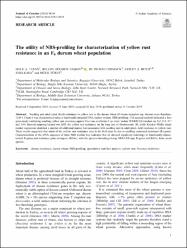| dc.contributor.author | Tufan, Hale A. | |
| dc.contributor.author | Taşkın, Belgin Göçmen | |
| dc.contributor.author | Maccormack, Ruth | |
| dc.contributor.author | Boyd, Lesley A. | |
| dc.contributor.author | Kaya, Zeki | |
| dc.contributor.author | Türet, Müge | |
| dc.date.accessioned | 2020-11-20T14:41:06Z | |
| dc.date.available | 2020-11-20T14:41:06Z | |
| dc.date.issued | 2019 | |
| dc.identifier.issn | 0022-1333 | |
| dc.identifier.issn | 0973-7731 | |
| dc.identifier.uri | https://doi.org/10.1007/s12041-019-1143-9 | |
| dc.identifier.uri | https://hdl.handle.net/20.500.12809/871 | |
| dc.description | WOS: 000492591400001 | en_US |
| dc.description.abstract | Seedling and adult plant (field) resistance to yellow rust in the durum wheat (Triticum turgidum ssp. durum) cross Kunduru-1149 x Cham-1 was characterized using a functionally-targeted DNA marker system, NBS-profiling. Chi-squared analysis indicated a four gene model conferring seedling yellow rust resistance against Puccinia striiformis f. sp. tritici isolate WYR85/22 (virulent on Yr2, Yr6, Yr7 and Yr9). Interval mapping located two QTL for yellow rust resistance on the long arm of chromosome 1B, while Kruskal-Wallis single marker regression identified a number of additional marker loci associated with seedling and/or adult plant, field resistance to yellow rust. These results suggested that much of the yellow rust resistance seen in the field may be due to seedling expressed resistance (R) genes. Characterization of the DNA sequence of three NBS marker loci indicated that all showed significant homology to functionally-characterized R-genes and resistance gene analogues (RGAs), with the greatest homology being NBS-LRR-type R-genes and RGAs from cereal species. | en_US |
| dc.description.sponsorship | Bogazici University Research FundBogazici University [04HB101]; TUBITAK - The Scientific and Technical Council of TurkeyTurkiye Bilimsel ve Teknolojik Arastirma Kurumu (TUBITAK) [TBAG-2357-103T178]; British Society of Plant Pathology; EMBO Fellow Grant [ASTF109-2004] | en_US |
| dc.description.sponsorship | The authors are grateful to Dr. M. Nachit of ICARDA, Syria for creating the Kunduru-1149 x Cham-1 cross and to the Central Research Institute, Ankara, Turkey for providing the study material. This study was supported by Bogazici University Research Fund (04HB101); TUBITAK -The Scientific and Technical Council of Turkey, project number: TBAG-2357-103T178 and an EMBO Fellow Grant: ASTF109-2004. We would also like to thank the British Society of Plant Pathology for awarding Ms. Hale Tufan a M.Sc. bursary that enabled her to carry out part of her M.Sc. research work in the group of Dr. Lesley A. Boyd at the John Innes Centre. The Genbank accession numbers for NBS2-290, NBS3-290 and NBS2-350 are DQ978777, DQ978778 and DQ978779, respectively. | en_US |
| dc.item-language.iso | eng | en_US |
| dc.publisher | Indian Acad Sciences | en_US |
| dc.item-rights | info:eu-repo/semantics/openAccess | en_US |
| dc.subject | Disease Resistance | en_US |
| dc.subject | Durum Wheat | en_US |
| dc.subject | NBS-Profiling | en_US |
| dc.subject | Quantitative Trait Loci Analysis | en_US |
| dc.subject | Yellow Rust | en_US |
| dc.subject | Puccinia Striiformis | en_US |
| dc.title | The utility of NBS-profiling for characterization of yellow rust resistance in an F-6 durum wheat population | en_US |
| dc.item-type | article | en_US |
| dc.contributor.department | MÜ, Fen Fakültesi, Biyoloji Bölümü | en_US |
| dc.contributor.institutionauthor | Taşkın, Belgin Göçmen | |
| dc.identifier.doi | 10.1007/s12041-019-1143-9 | |
| dc.identifier.volume | 98 | en_US |
| dc.identifier.issue | 4 | en_US |
| dc.relation.journal | Journal of Genetics | en_US |
| dc.relation.publicationcategory | Makale - Uluslararası Hakemli Dergi - Kurum Öğretim Elemanı | en_US |


















